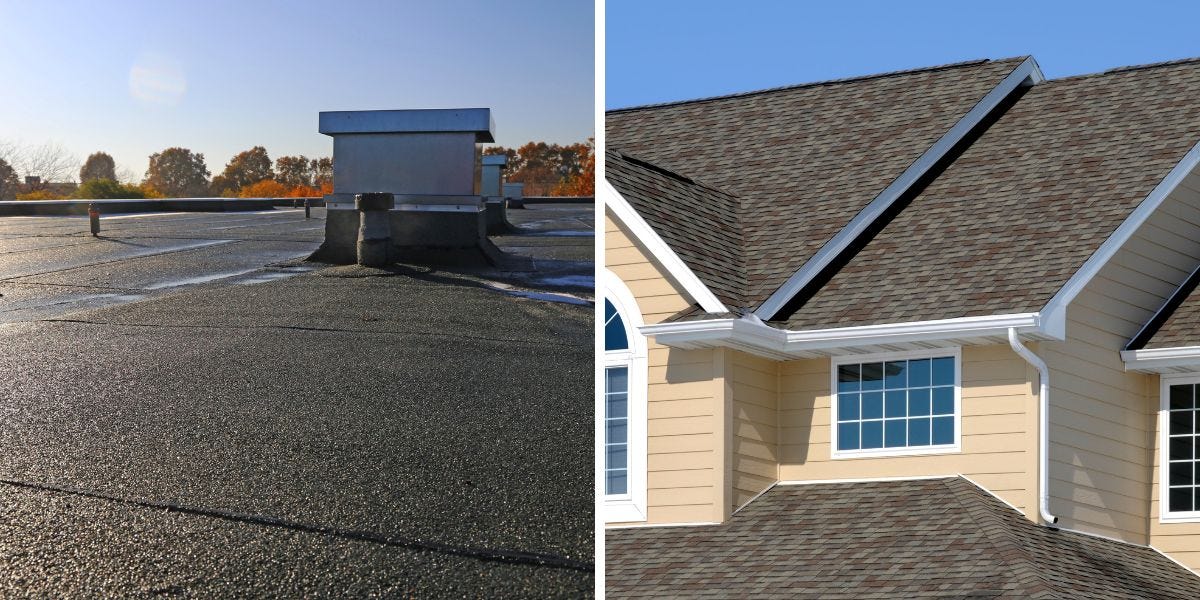HOME
Flat Roofs Vs. Pitched Roofs: Which is Right for Your Home?

Choosing the right roof for your home is a significant decision that impacts not only the aesthetic appeal but also the functionality and longevity of your property. Whether you’re building a new home or considering a roof replacement, understanding the differences between flat and pitched roofs can help you make an informed choice. In cities like Akron, where weather conditions can vary, it’s crucial to consider the unique advantages and potential drawbacks of each roofing type. This article will explore the design differences, benefits, common issues, and costs associated with flat and pitched roofs to guide your decision on roofing Akron homes effectively.
Design Differences: Structural Aspects and Aesthetic Appeal
1. Structural Aspects
- Flat Roofs: Flat roofs are characterized by a slight pitch, typically between 1-10 degrees, allowing for minimal water runoff. The structure is simpler and often less expensive to construct due to fewer materials and a straightforward design. Flat roofs are common in commercial buildings but have gained popularity in residential designs for their modern appeal.
- Pitched Roofs: Pitched roofs feature a steeper incline, often between 20-70 degrees, which helps with efficient water and snow runoff. The structure requires more complex engineering and materials, contributing to higher initial construction costs. Pitched roofs are traditional in residential architecture and are well-suited for regions with heavy rainfall or snowfall.
2. Aesthetic Appeal
- Flat Roofs: In keeping with other modern architectural forms, flat roofs provide a clean, contemporary appearance. They provide a minimalist aesthetic that can be visually striking, particularly in urban settings where modern design is prevalent.
- Pitched Roofs: Pitched roofs provide a classic, timeless appearance that is often associated with traditional home designs. They can enhance the character of a home and are available in various styles, including gable, hip, and mansard roofs, allowing for greater customization to match the overall architectural theme.
Advantages of Flat Roofs
- Space Utilization: Flat roofs offer additional usable space that can be transformed into rooftop gardens, patios, or solar panel installations. This is particularly beneficial in urban areas where outdoor space is limited.
- Modern Look: The clean, horizontal lines of flat roofs contribute to a modern, streamlined aesthetic that appeals to contemporary design preferences. This style can make a home stand out in a neighborhood of traditional homes.
- Easier Maintenance: Maintenance tasks, such as gutter cleaning, inspections, and repairs, are more accessible on flat roofs due to the lack of steep inclines. This can result in lower maintenance costs and safer working conditions for roofing contractors.
Advantages of Pitched Roofs
- Better Water Drainage: The steep incline of pitched roofs ensures efficient water runoff, reducing the risk of water pooling and leaks. This design is particularly advantageous in regions with heavy rainfall.
- Longevity: In comparison to flat roofs, pitched roofs tend to last longer and are more robust. The efficient drainage system minimizes water damage, and the materials used, such as asphalt shingles, metal, or tiles, are designed to withstand various weather conditions.
- Traditional Style: Pitched roofs offer a classic look that can enhance the home’s curb appeal. The variety of styles and materials available allows homeowners to customize their roofs to fit the architectural style of their homes, from rustic cottages to elegant Victorian houses.
Common Issues and Solutions
1. Flat Roof Drainage
Flat roofs can suffer from water pooling, leading to leaks and structural damage. However, installing a high-quality drainage system, such as internal drains, gutters, and scuppers, can effectively manage water runoff. Regular maintenance and inspections are also crucial to ensure the drainage system remains clear of debris.
2. Pitch Roof Wind Resistance
Pitched roofs can be vulnerable to wind damage, especially in areas prone to high winds or storms. Using wind-resistant materials and ensuring proper installation techniques can mitigate the risk of wind damage. Reinforcing the roof structure and securing shingles or tiles with strong adhesives can also enhance wind resistance.
Cost Comparisons: Installation, Maintenance, and Repair Costs
1. Installation Costs
- Flat Roofs: Typically, flat roofs are less expensive to install due to their simpler design and reduced material requirements. However, the cost can vary depending on the materials, such as rubber, PVC, or modified bitumen.
- Pitched Roofs: The installation cost of pitched roofs is generally higher due to the complexity of the design and the increased amount of materials needed. The type of roofing material, such as asphalt shingles, metal, or tiles, also affects the overall cost.
2. Maintenance Costs
- Flat Roofs: Maintenance for flat roofs is usually more straightforward and less expensive. Regular inspections and clearing of drainage systems can prevent major issues. However, flat roofs may require more frequent maintenance due to potential water pooling.
- Pitched Roofs: While maintenance can be more challenging due to the steep incline, pitched roofs typically require less frequent repairs. Efficient drainage reduces the likelihood of water damage, and durable materials contribute to lower long-term maintenance costs.
3. Repair Costs
- Flat Roofs: Repairs for flat roofs can be relatively simple and cost-effective, especially if issues are caught early. Common repairs include patching leaks and resealing joints.
- Pitched Roofs: Repairing pitched roofs can be more expensive due to the complexity of accessing and fixing issues on a steep incline. However, the need for repairs is generally less frequent compared to flat roofs.
Conclusion
Deciding between a flat roof and a pitched roof involves weighing various factors, including design preferences, structural requirements, and cost considerations. Flat roofs offer a modern look, efficient space utilization, and easier maintenance, making them ideal for contemporary homes and urban settings. On the other hand, pitched roofs provide better water drainage, enhanced durability, and a traditional aesthetic, suitable for homes in regions with significant rainfall or snow.
For homeowners in Akron and Canton, consulting with a knowledgeable roofing contractor is essential to determine the best option for your needs. A Canton roofing contractor, such as Prestige Exteriors, can provide expert advice, quality materials, and professional installation to ensure your roof complements your home’s design and offers long-lasting protection against the elements.
Stay ahead of the curve with the freshest news updates by exploring TodayFirstMagazine!







